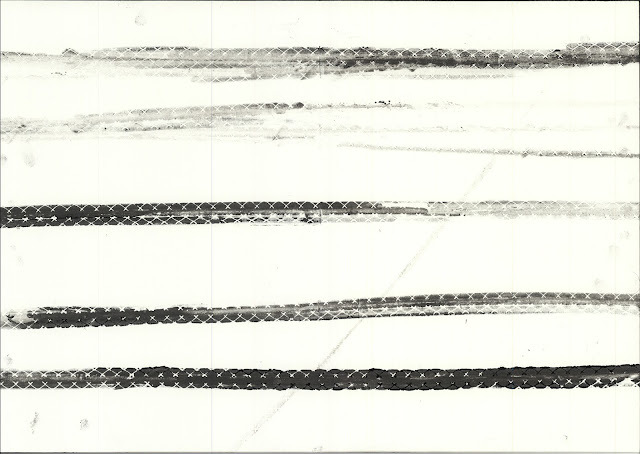I have never attempted to printing a bicycle tyre therefor I have to apply my knowledge and experience with relief printing processes in order to produce a clean print. When Robert Rauschenberg printed the car tyre, he inked up the tyre and used pieces of paper stuck together in a line in order to get a long, straight print.
Specialist Advice
I went to the traditional print studio and explained the problem to Mike and the technicians. They suggested cutting up a section of a tyre to give more control and accuracy when printing, however I am yet to source a tyre and it is likely that I will have to borrow someones bike for me to use so cutting the tyre up wouldn't be appropriate. I suggested to the technicians two ideas:
- Roll out a long plate of ink and cycle over it to coat the tyre (like rolling an ink roller) and continue onto a piece of paper.
- Use an ink roller and manually ink up the tyre to achieve an even coverage. As the poster is limited to A3, I can ink up part of the tyre to avoid mess and wasting ink.
Mike pointed out that the ink plate will need to be very long in order for it to coat the complete tyre, therefor I aim to experiment with concept 2.
In order to get hold of a bicycle tyre, I rang a range of cycling shops in Leeds requesting any unwanted or damaged tyres as I am aware that they offer services in replacing them. After trying 3 stores in Leeds; Cycle Surgery, Evans, and The Bike Shop Leeds they said that they didn't have any for me to take off their hands. To overcome this I resorted to borrowing a colleagues bike (like Rauschenberg borrowing his friends car!) so that I could experiment.
Consideration
I made sure the bike available was fit with racing tyres, meaning that they are thin and slender. This will be an accurate representation of the bikes used in the TDF.
Process:
Using my living room, I laid out sheets of newsprint to act as a 'runway for the bike':
I used some block printing ink which was slightly more runny than the oil based inks I am used to using. A piece of greyboard provided a sufficient inking plate for me to role an even coverage of ink on to which I then rolled directly onto the tyre. Rauschenberg inked up the back tyres of the car, presumably because the car was front wheel drive, or there was more weight at the back of the car.
Using the little knowledge I knew from Rauschenberg, I inked up the rear tyre of the bike. I printed onto a range of different stock from standard A3 printer paper, newsprint and textured water colour paper.
Rear Tyre:
Overlapped the tyre marks to make the composition more dynamic and suggest the movement of the cyclists. The variety of tones from where the ink started to wear away also suggests movement as it resembles the cyclists passing by and fading into the distance.
Printed on standard A3 printer stock:
The tyres didn't retain the ink as well as I'd thought as I only had a maximum of 2 presses before the tyre needed inking up again.
A problem with partially inking up the tyre was the fact that it was hard to establish where the ink was applied to the tyre which made some print runs completely blank.
Front Tyre:
Resorted to using the front tyre because I had more control over direction and I could apply more pressure. I released the air from the tyre so that more surface area was available to print with.
Watercolour Paper:
Newsprint:
After experiencing printing with the tyre, changing direction became very problematic, this is clear evidence to suggest that Rauschenberg inked the rear tyres of the car because steering corrections churn and rip the paper.











No comments:
Post a Comment